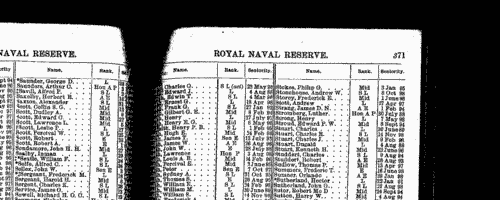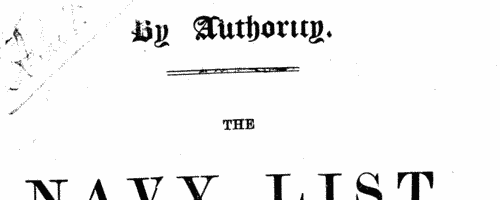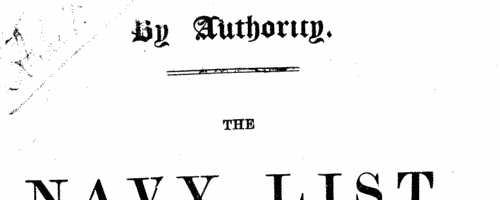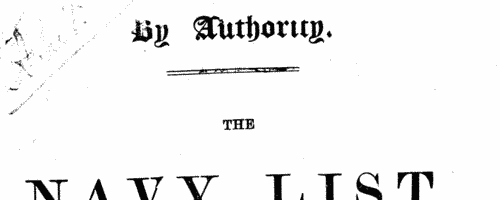Add this eBook to your basket to receive access to all 171 records. Our indexes include entries for the spelling highfield. In the period you have requested, we have the following 171 records (displaying 141 to 150): These sample scans are from the original record. You will get scans of the full pages or articles where the surname you searched for has been found. Your web browser may prevent the sample windows from opening; in this case please change your browser settings to allow pop-up windows from this site. Associates of King's College, London
(1896)
Former students of King's College, London, could be elected as associates of the college, and then enjoyed the privilege of perpetual free admission to all the classes in the department from which they had been elected; the use of the libraries and museums on the same basis as current students; and admission to dine at high table in the college hall. This list of associates from the college calendar for 1896-1897 gives year of election, full name (surname first), and the faculty or department in which graduated, of all associates elected from 1866 to 1896. | Sample scan, click to enlarge

| Officers of the Royal Naval Reserve
(1898)
The Navy List, published by Authority, corrected to 18 December 1898, has this list of the officers on the Active List of the Royal Naval Reserve and of Honorary Officers of the reserve. Each officer's surname, christian name, and any middle initial(s) is given; with rank, and date of seniority in that rank. The ranks are: A E, Assistant Engineer; E, Engineer; Hon A P, Honorary Assistant Paymaster; Hon Ch E, Honorary Chief Engineer; Hon Cr, Honorary Commander; Hon L, Honorary Lieutenant; Hon P, Honorary Paymaster; Hon S L, Honorary Sub-Lieutenant; L, Lieutenant; Mid, Midshipman; S L, Sub-Lieutenant; Sen E, Senior Engineer. | Sample scan, click to enlarge

| Officers of H. M. S. Tyne, in the Mediterranean
(1904)
The Monthly Naval List for November 1904, printed By Authority for the Admiralty, contains this List of Ships and Vessels of the Royal Navy with their Officers and Present Stations. The number after the name of the ship denotes the number of guns of 4-inch calibre and upwards. The tons represents the displacement tonnage. A letter P. in bold denotes Paddle Wheel; S. Single Screw. The italic abbreviations are F. D. Forced Draught; I. H. P. Indicated Horse Power; N. D. Natural Draught. All officers whose names are in italics are borne as supernumeraries or additions. (G) against an officer's name denotes that he is borne for gunnery duties; (N) navigating; (T) torpedo. In the cases where two dates are shown against the names of marine officers, the date in brackets is that from which his present sea time commenced. | Sample scan, click to enlarge

| Officers of the Royal Navy
(1904)
The Monthly Naval List for November 1904, printed By Authority for the Admiralty, contains this Alphabetical List of the Officers on the Active List of the Royal Navy and the Royal Marines with the Dates of their Seniority. The first column 'Where serving' gives the number of the ship; the second column gives full name, surname first, but with middle names represented only by initials; the third column rank; and the fourth column seniority, i. e., the date of attaining that rank. Lieutenants whose seniorities are printed in italics are on the Supplementary List, and Engineer Lieutenants whose seniorities are printed are those not yet advanced. | Sample scan, click to enlarge

| Supplementary Lieutenants of the Royal Navy
(1904)
The Monthly Naval List for November 1904, printed By Authority for the Admiralty, contains this List of Officers on the Active List of the Royal Navy with the Dates of their Seniority. The list is arranged by rank, and then by date of seniority: full names, including full middle names, are given. Each name is preceded (where appropriate) by the number of the ship in which serving; an 'm' indicating the holder was entitled to wear a medal; one or more asterisks for officers authorized to hold foreign orders. (C) after the name denotes an officer who had obtained his lieutenant's commission by competition at the Royal Naval College; (E) one who had obtained the same for meritorious examination there; or (G) one who had received an honorary certificate or had qualified as a Gunnery or Torpedo Lieutenant. There are also various sets of initials in italics indicating: AdC Aide-de-Camp to the King, AO Clerk to Secretary to a Flag Officer, CG Coast Guard, CGP Coast Guard Pension, Coll studying at Naval College, Dev an acting sub-lieutenant studying at Devonport, DY Dock Yard, GH Greenwich Hospital, GHP Greenwich Hospital Pension, GSP Good Service Pension, KHC Honorary Chaplain to the King, KHP Honorary Physician to the King, KHS Honorary Surgeon to the King, NH Naval Hospital, NID Naval Intelligence Department, NP Naval Pension, Po an acting sub-lieutenant studying at Portsmouth, PW Pension for Wounds, RNVR Royal Naval Volunteer Reserve, SC undergoing short course of instruction in torpedo, gunnery, &c., ScM Royal Naval School of Music, Sec Secretary to a Flag Officer, TB Torpedo Boat, TP Travers Pension, TS Transport Service, VY Victualling Yard. Large or bold letters in brackets or circles indicate qualifications in - G gunnery, I interpreting, N navigating, S secretary, T torpedo. There are lists for Flag Officers (Admirals of the Fleet, Admirals, Vice-Admirals, and Rear Admirals); Captains; Commanders; Lieutenants; Supplementary Lieutenants; Sub-Lieutenants (with class of their certificates in seamanship, navigation, pilotage, gunnery and torpedo); Midshipmen; Navy Cadets; Staff Captains; Engineer Rear-Admirals; Engineer Captains; Engineer Commanders; Engineer Lieutenants; Engineer Sub-Lieutenants; Chaplains (where these also acted as Naval Instructors, their seniority in that appointment is given as well); Naval Instructors (where these also acted as Chaplains, their seniority in that appointment is given as well); (Medical) Inspector-Generals of Hospitals and Fleets; Fleet Surgeons; Staff Surgeons; Surgeons; Paymasters-in-Chief; Fleet Paymasters; Staff Paymasters; Paymasters; Assistant Paymasters; Clerks; Assistant Clerks; Carpenter Lieutenants; Chief Gunners; Gunners; Chief Boatswains; Boatswains; Chief Signal Boatswains; Signal Boatswains; Chief Carpenters; Carpenters; Chief Artificer Engineers; Artificer Engineers; Chief Schoolmasters; Head Schoolmasters; Head Wardmasters. | Sample scan, click to enlarge

| Music academics
(1905)
The calendar of the Trinity College of Music, London, for 1905-1906 includes a section listing organ associates and certificated organists. | Sample scan, click to enlarge

| Somerset Chess Team (1905)
Members of the local chess team named in the results of tournaments recorded in the British Chess Magazine
| Sample scan, click to enlarge

| Steam Engine Makers in Birkenhead
(1910)
The Steam Engine Makers' Society, a trades union, ended 1910 with 13,401 members in 144 branches. The 86th Annual Report gives a full list of members for each branch, followed by Travelling Expenses subsidised by the branch (with names and dates); Unemployed Expenses (with names and dates); Superannuation, Sick and Funeral Expenses (all with names and dates). | Sample scan, click to enlarge

| Soldiers wounded in the Great War: North Staffordshire Regiment
(1916)
Lists of names of soldiers wounded, died of wounds, died, missing presumed dead, and taken prisoner by the enemy, were issued to the British national press under the title Roll of Honour. Each man is identified by surname, initials and number. The regimental returns from which the daily Roll was compiled were made up over the previous week or weeks. Each regimental return may be partial, covering only part of the alphabet. The lists are provisional, in that a man reported wounded one day may appear as died of wounds later; a missing presumed dead may later be reported as having been found, or as having died; the lists of prisoners of war were provided by the enemy and will relate to captures weeks earlier. However, these rolls are the most comprehensive single source of names of British and allied combatants meeting with misfortune in the Great War. This is the roll published 4 August 1916. | Sample scan, click to enlarge

| Chemists and Druggists
(1919)
The official register printed under the direction of the Pharmaceutical Society of Great Britain pursuant to the act of 31 & 32 Victoriae, cap. 121 (An Act to Regulate the Sale of Poisons, and Alter and Amend the Pharmacy Act, 1852) comprised two sections:
1.The Register of Pharmaceutical Chemists, giving date of registration, number of examination certificate, full name (surname first, in capitals), and residence;
2. The Register of Chemists and Druggists, giving date of registration, full name (surname first, in capitals), residence, number of examination certificate (major or minor), and qualification. | Sample scan, click to enlarge

|
Research your ancestry, family history, genealogy and one-name study by direct access to original records and archives indexed by surname.
|











